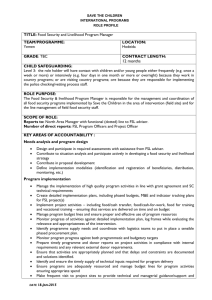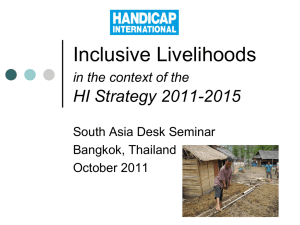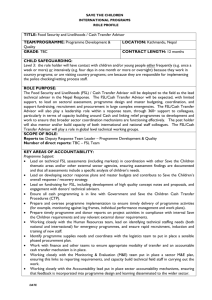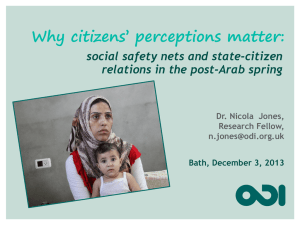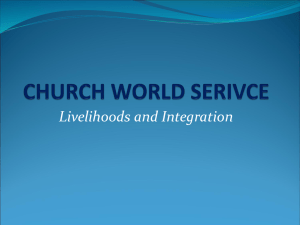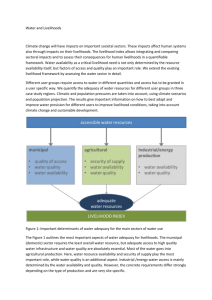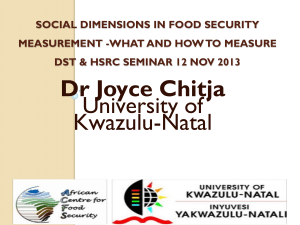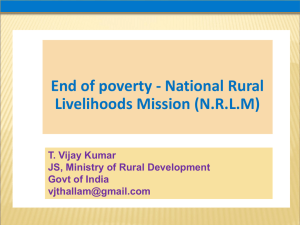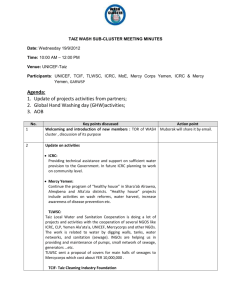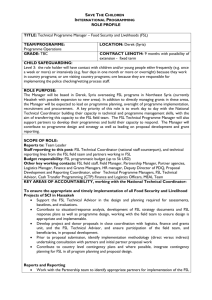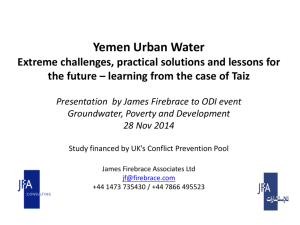Market Assessment and Value Chain Analysis of
advertisement
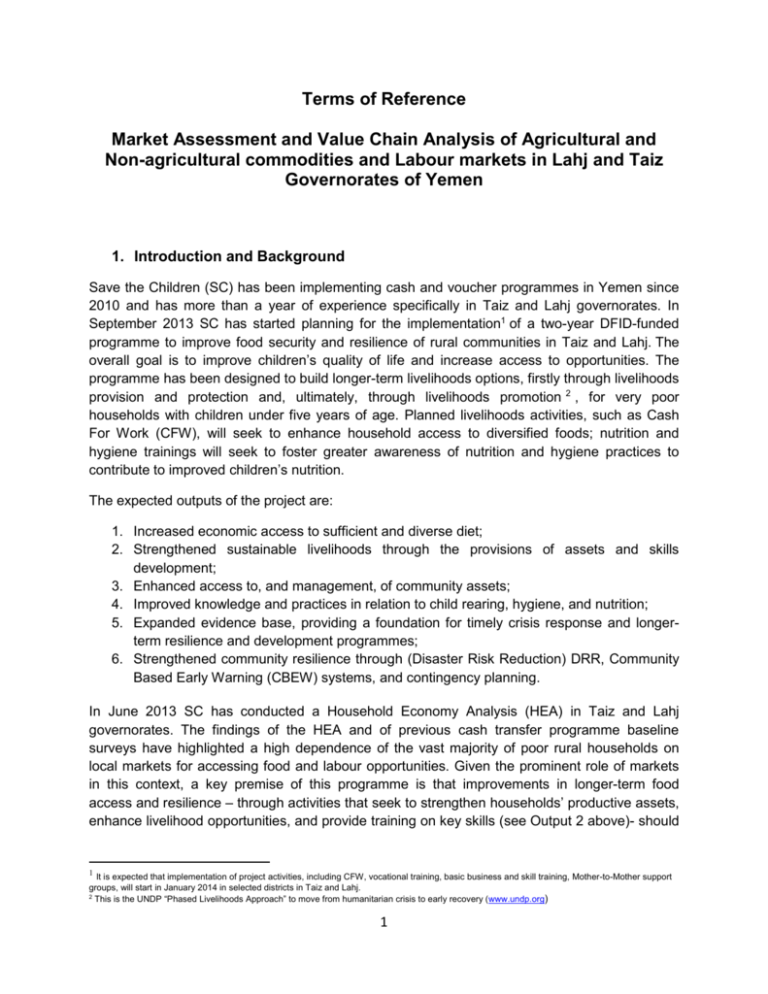
Terms of Reference Market Assessment and Value Chain Analysis of Agricultural and Non-agricultural commodities and Labour markets in Lahj and Taiz Governorates of Yemen 1. Introduction and Background Save the Children (SC) has been implementing cash and voucher programmes in Yemen since 2010 and has more than a year of experience specifically in Taiz and Lahj governorates. In September 2013 SC has started planning for the implementation1 of a two-year DFID-funded programme to improve food security and resilience of rural communities in Taiz and Lahj. The overall goal is to improve children’s quality of life and increase access to opportunities. The programme has been designed to build longer-term livelihoods options, firstly through livelihoods provision and protection and, ultimately, through livelihoods promotion 2 , for very poor households with children under five years of age. Planned livelihoods activities, such as Cash For Work (CFW), will seek to enhance household access to diversified foods; nutrition and hygiene trainings will seek to foster greater awareness of nutrition and hygiene practices to contribute to improved children’s nutrition. The expected outputs of the project are: 1. Increased economic access to sufficient and diverse diet; 2. Strengthened sustainable livelihoods through the provisions of assets and skills development; 3. Enhanced access to, and management, of community assets; 4. Improved knowledge and practices in relation to child rearing, hygiene, and nutrition; 5. Expanded evidence base, providing a foundation for timely crisis response and longerterm resilience and development programmes; 6. Strengthened community resilience through (Disaster Risk Reduction) DRR, Community Based Early Warning (CBEW) systems, and contingency planning. In June 2013 SC has conducted a Household Economy Analysis (HEA) in Taiz and Lahj governorates. The findings of the HEA and of previous cash transfer programme baseline surveys have highlighted a high dependence of the vast majority of poor rural households on local markets for accessing food and labour opportunities. Given the prominent role of markets in this context, a key premise of this programme is that improvements in longer-term food access and resilience – through activities that seek to strengthen households’ productive assets, enhance livelihood opportunities, and provide training on key skills (see Output 2 above)- should 1 It is expected that implementation of project activities, including CFW, vocational training, basic business and skill training, Mother-to-Mother support groups, will start in January 2014 in selected districts in Taiz and Lahj. 2 This is the UNDP “Phased Livelihoods Approach” to move from humanitarian crisis to early recovery (www.undp.org) 1 be informed by a robust understanding of market dynamics, to ultimately ensure the livelihood activities promoted can appropriately respond to existing market demand. To this effect SC is currently seeking to determine which livelihood activities (agricultural and non-agricultural) hold promise of better employment opportunities, product expansion, market viability, value addition opportunities, quality improvement and input availability for small producers. Depending on the items identified, cost and availability in local markets, SC will provide beneficiaries with appropriate assets (in-kind or through cash). Agricultural and livestock inputs may for instance include improved seeds, tools, materials for irrigation systems and materials for beekeeping; additional inputs could include livestock, animal healthcare equipment, or toolkits for carpentry or masonry. SC will also provide key training to male and female beneficiaries to enhance traditional livelihoods, reducing inputs and increasing profit (e.g. how to reduce wastage in milk processing or to produce higher quality products, change livestock feeding practices or use waste water for irrigation) and/or create alternative livelihood opportunities (e.g. brick-making, carpentry, sewing or food processing). In addition, a small number of beneficiaries will be targeted with vocational training (e.g. on carpentry, electrics, car mechanics, brick making, tile making, mobile phone maintenance, food processing). These speciality trainings will be provided in addition to literacy, numeracy, business skills and market training. Where feasible, SC will connect beneficiaries with micro-finance institutions and will seek opportunities for private sector partnerships to pilot apprenticeships for vocational training beneficiaries. SC is currently seeking to identify the exact specialisations of key and vocational trainings, and to determine the feasibility of linking beneficiaries with micro-finance institutions and private sector partnerships. 2. Objectives The overall objective of this assignment is to carry out a Value Chain Analysis and Market Assessment of agricultural and non-agricultural commodities and labour markets in Taiz and Lahj governorates (and beyond as appropriate) to provide evidence-based information to programme design. In particular, the Value Chain Analysis and Market Assessment should shed light on the status and viability of existing and potential markets and determine which hold promise of employment opportunities, product expansion, market viability, value addition opportunities, quality improvement and input availability to small producers. The specific objectives are: (1) Review existing Value Chain Analyses and Market Assessments of agricultural and nonagricultural products and labour markets, SC’s recent Household Economy Analysis and other relevant project documents. (2) Draft an appropriate methodology for primary data collection and develop data collection tools (e.g. market survey, interviews with market actors, key informant interviews) that will be used to conduct the Market Assessment and Value Chain Analysis (to be reviewed by SC). The methodology should specifically consult, and identify opportunities for, women, youth and teenagers (male and female). (3) Plan and conduct a Market Assessment and Value Chain Analysis focusing on: 2 - identification of major local, regional and, if applicable, distant markets assessment of size of markets, volume of sales, market integration/segmentation local market structure and enabling environment (e.g. security issues or policies affecting market access) - market actors (consumers, sellers, traders, middle-men, employers) behavior - procurement mechanisms, market requirements (standards, conditions for delivery) and prices, wage rates and employment conditions - Other areas as identified by the methodology and data collection (4) Draft a Market Analysis and Value Chain Analysis report, which includes an executive summary and practical recommendations that can be used to inform SC’s food security and livelihoods intervention in Taiz and Lahj and ensure viability, appropriateness, and ultimately sustainability. 3. Process & Deliverables Phase 1: Plan of Action Based on this TOR the consultant will draw up a Plan of Action (3-5 pages). The Plan of Action will be sent to the FSL Advisor and Director of Programme Development and Quality by the end of the first week of the assignment. The Plan of Action will include the proposed approach of the candidate, methodology, a broad time frame and budget. It will also explain how the involvement of SC experts and stakeholders will be ensured. The Plan of Action will include a clear description of the different enterprise groups to be analysed. Phase 2: Desk Review Based on the desk review a revised Plan of Action will be presented. This plan of action includes an inception report presenting the initial results, information gaps and the proposed approach to fill these information gaps. Phase 3: Fieldwork and Draft report The consult will deliver and present the draft report covering the key findings and results to SC staff, and other relevant stakeholders. Feedback on the draft report will be incorporated into a final version of the report. Phase 4: Dissemination of final report The final market assessment and VCA report will be circulated to key stakeholders as identified by SC. 3 Note As stated above in the deliverables section the final document has to clearly and explicitly indicate: a. The added values the SC FSL project could bring to these value chains Define the challenges and the opportunities the selected value chain holds for small producers. This includes, at least: o Identification of the types of value chain(s) that offer better opportunities in the local and distant markets and what requirements have to be met to exploit those opportunities o Areas of improvement for better production and productivity to increase competitiveness of the small producers engaged in the value chain o Opportunities for better employment and income for the small producers o Identification of sustainable development potentials in the value chain b. Prepare a complete value chain map showing who is the chain actors, stakeholders, supporters and influencers, how many they are, values and volumes handled, all units disaggregated by gender including a detailed stakeholders analysis. c. The potentials for integration of small producers in the value chain d. Identification of possible improvements that can lead to significant increases in employment and income for the small producers e. Provision of analysis of potential risks that may hamper reaching SCI’s goals for the value chain. The analysis should provide narratives if the bottlenecks are critical (i.e. the project would fail to increase opportunities for small produces if the bottlenecks are not removed as planned and the level of risk that the bottlenecks identified will not be removed on short-term , with in the project life span f. A recommendation on how the project shall pursue its interventions in the face of findings on the ground. 4. Reporting The final report submitted to SC will include separate recommendations and an implementation plan, in a separate 2 to 3 pages document, which outlines where SC can contribute based on the project activities to alleviate the bottlenecks identified in the value chain analysis within the time span of the project (2 years to 31st August 2015). The consultant will work closely and in coordination with the SC DFID FSL sector team, specifically the Senior Programme Manager, FSL advisor and Director of Program Development and Quality, as well as the SCUK FSL advisor. 5. Ownership and Beneficiaries of the study Any and all documents produced under this assignment shall be the sole property of SC and may be used for any purpose whatsoever without the need to consult with the author. The key beneficiaries of the study are the local communities within the project area, as the study will support them in understanding the local market dynamics and also support those interested in value chain of their agriculture and non-agriculture products. In addition the assessment report will be aimed at a range of stakeholders such as donors, public policy makers and other stakeholders including other INGOs working on FSL in Yemen. The findings of this study will also be used to raise the awareness level of the policy makers at the strategic, tactical and operational levels and propose alternative mechanisms for small producers for better livelihood options. 4 6. Competencies Strong analytical skills Ability to work under pressure in challenging environments Capacity to dialogue with different sectors Excellent communication skills Arabic language skills will be a plus Determination and focus on goals and results Sound management and effective facilitation skills 7. Skill and knowledge base requirements: Excellent knowledge of value chain analysis in Yemen, the Middle East or East Africa Strong analytical, research and presentation skills 8. Application Process Interested applicants should send a CV, with a covering letter explaining how their experience addresses the requirements of the TOR to Lucille Tapfumaneyi, Senior HR Manager: Lucille.Tapfumaneyi@savethechildren.org by 14th November. 5
